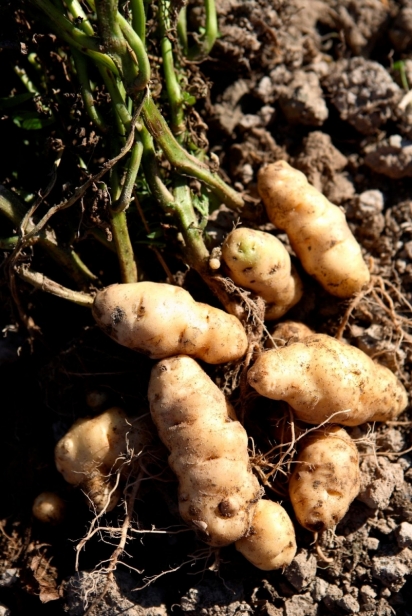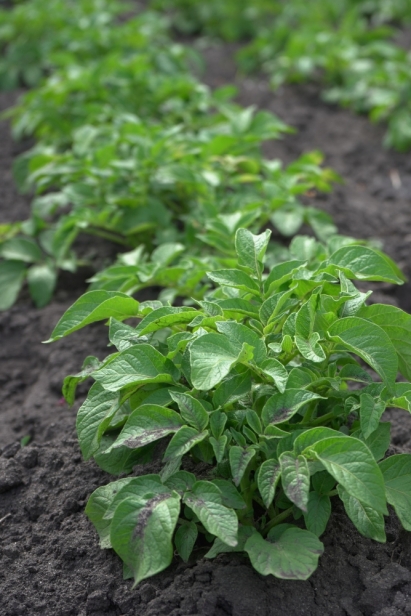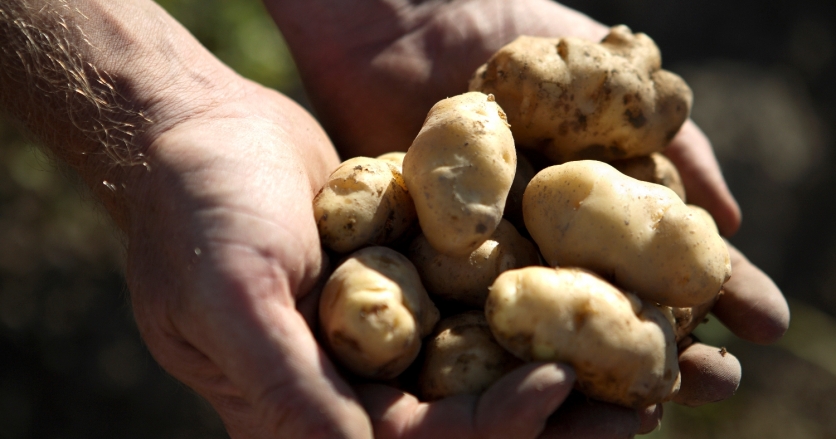Wild, Gangly and Endlessly Adaptable
Here’s a food mystery wrapped up in a historical enigma — the riddle being how and where did the rare Ozette potato arrive in British Columbia?
It’s a question that’s been asked by historians and a mystery probed by scientists, but one that’s closer to being unraveled thanks to First Nations people, seed savers, slow food advocates and modern gene sequencing technology.
What’s really interesting about this special spud is that it seems to have arrived in the Pacific Northwest directly from the Andes with the earliest Spanish explorers, and not via the more circuitous route the humble potato took via Europe, then back to North America, with colonists years and generations later.
And, thanks in part to that provenance, the Ozette is a potato that people are keen to plant again today.
What is an Ozette?
An Ozette potato is a buff-coloured fingerling covered with many deep-set eyes, giving the tuber a bumpy, almost tufted appearance.
In the Haida language, this potato is known as Xaadas sgúusadaa, or “long and skinny.” It may be small — literally finger sized — but can grow up to eight inches long. Its many eyes make the Ozette prolific — every eye can sprout and start a new plant — but also less than ideal for modern commercial production, as it’s hard to clean and peel.
In the central Andes of South America (Peru, Chile, Argentina, Bolivia), where wild potatoes were first domesticated, more than 3,500 varieties are still grown and the Ozette is a direct descendant. Dense and firm, with what some describe as a “nutty” flavour akin to roasted chestnuts, the Ozette is unlike any of the commercial potatoes you’ll find in supermarkets today But it’s well adapted to B.C.’s coastal climate and grown by a handful of small farmers and gardeners here.
Spanish conquistadors on our shores
So how and when did the gnarly little Ozette get here? The back story is somewhat convoluted.
In the 16th century, Spanish conquistadors arrived in South and Central America, on a mission to claim land and resources for their European masters. Conquering the Incas in Peru and the Aztecs in Mexico, these Spanish invaders seized gold and silver and also picked up an interesting New World vegetable — the potato.
By the late 1700s, the Spanish had made their way to the Pacific Northwest, leaving these golden fingerlings behind in areas where they landed to colonize our coastline.
It was 1774 when the Spanish first made contact with the Indigenous people of Haida Gwaii (also known as the Queen Charlotte Islands). In 1789, they established Santa Cruz de Nuca (or Nutca/Nootka) at the Mowachaht (Nuuchah-nulth) community of Yuquot (Friendly Cove) on Vancouver Island — the first European colonial settlement in what is now British Columbia. Around the same time, in 1791, Spanish colonists arrived in the Makah communities of Neah Bay (in what is now Washington State) and built another short-lived fort.
The heirloom potatoes we know as Ozettes, named for a lake near Neah Bay, have been growing in these regions ever since. And through modern gene sequencing, scientists have now confirmed that these potatoes — whether Makah Ozette, Nootka/Yuquot or Haida — are indeed the same variety of native Andean potatoes that arrived on Spanish galleons more than two centuries ago.
A penchant for potatoes
It’s probably not surprising that coastal First Nations took kindly to the potatoes that the Spanish planted in their food gardens, for they had been harvesting the tiny, edible corm of the wild mountain potato, or sunt’iny (Claytonia lanceolata) for centuries, especially in spots such as Tsinuzch’ed (Potato Mountain) in B.C.’s Chilcotin region.
But the story of Indigenous potato production in B.C., and the source of these spuds, has not been straightforward. Historians once surmised that the potatoes some First Nations families had grown for generations were European varieties, first introduced at the Hudson's Bay Company post at Fort Langley in 1828.
University of Victoria ethnobotanist Nancy Turner later unearthed evidence that Indigenous people were growing and trading potatoes long before that.
Turner writes that the Haida of the Queen Charlottes “became renowned for their expertise in potato production,” in her book, Traditional Plant Foods of Canadian Indigenous Peoples. “Haida [potatoes] were grown, not only for local consumption, but were traded or sold to the Tsimshian and other mainland peoples, and to trading ships and nearby Hudson's Bay Company posts.”
The potatoes that Turner collected from First Nations communities — whether specimens from Haida Gwaii and Kassan, Alaska, the Tlingit Maria’s Potato or the Ozette from the Makah on Washington’s Olympic Peninsula — were genetically identical and directly related to the original South American cultivars.
Writing in the University of Victoria’s anthropology journal, PlatForum, Stella Wenstob details the profusion of potatoes in pre-colonial British Columbia, referencing various letters and writings from early traders and explorers to coastal areas.
She concludes that with Neah Bay just across the Salish Sea from Port Renfrew on Vancouver Island, and about 100 nautical miles from Nootka Sound, the Makah and Mowachaht people likely traded and shared the potatoes left behind when the Spanish abandoned their colonial settlements in the late 17th century.
There’s also evidence, she writes, that First Nations were cultivating potatoes, along with other edible starchy bulbs such as camas, wapato and tiger lilies, and that the earliest European fur traders on the northern coast subsisted on potatoes they obtained from the Tsimshian, Nisga’a and Haida people. An 1840 report from the chief factor at the Fort Simpson trading post (now the Tsimshian community of Lax-Kw'alaams) describes receiving 119 bushels of potatoes from Haida Gwaii, arriving in 48 canoes.
It’s unclear whether these potatoes originated via trade with people from Nootka Sound or came directly from interactions with Spanish or Russian colonialists, but it seems that potatoes became an important commodity for First Nations, both as a trade good and a food source.
Wenstob references an 1858 article published in the Victoria Gazette, where early Indian agent William Eddy Banfield describes “a great feast among the Tla-o-qui-aht people that centred on the consumption of the prestigious trade good, potatoes,” in a potlatch for 300 guests.
Consumed with another valuable product, whale oil, the potato was the star of the feast.
Ozette potatoes resurface
Today, the obscure but hardy Ozette has emerged, at least in some circles, as the poster potato of the moment — symbolic for those interested in local food sovereignty, regenerative farming, climate change and Indigenous rights.
But the Ozette has taken a long and circuitous journey to make it back to B.C. gardens and farms. Though some Haida and Mowachaht families continued to cultivate these landrace potatoes, most of the Ozettes we see in B.C. today can be traced back to the Makah people of Neah Bay, and a handful of American heirloom seed savers.
A Makah gardener first shared her Ozette potatoes with an Idaho seed potato grower in the 1980s. The rare Indigenous spud subsequently made it into seed catalogues and gained a local following. Celebrated by Seattle chefs and slow food advocates, the Ozette was added to the Slow Food Ark of Taste in 2004.
On this side of the border, it was scientists and botanists who first propagated this potato.
Richard Hebda, retired curator of botany and earth history at the Royal B.C. Museum, was a pioneer in reviving interest in the Ozette and growing the potato in B.C.
“It came to me via Nancy Turner,” says Hebda, who first planted a few tubers 25 years ago on Vancouver Island where he continues to harvest Ozettes today. “I didn’t have very many of them, but I began growing them to produce additional tubers that could be made available to others.”
Hebda gave Ozettes away to eager gardeners and slow food followers, and the heirlooms were soon planted in the kitchen garden at Sooke Harbour House and by hobby growers and market gardeners.
After presenting his Ozette research to the organic gardeners at Lohbrunner Community Farm in Metchosin in 2017, parttime farmer Scott Harris took up the challenge to grow the island heirlooms.
“I got two small Ozette Nootka potatoes from him,” recalls Harris, “and I planted them and got six pounds from two hills.”
Harris says his six pounds of Ozettes yielded 120 pounds a year later. He’s still planting Ozettes and has even been experimenting with growing them from the potato berry or “true potato seed.”
“We now have some really nice Ozettes that don’t have viruses,” says Harris, who has developed some red- and purple-skinned Ozette offshoots, and still sells some of the unusual potatoes through the farm’s CSA box program.
But even among such small, innovative farmers, the Ozette remains a rare commodity.
Sourcing the spud
Finding a seed source for this potato in B.C. has been a bit of a scavenger hunt, too. Most of the heirloom seed potato and organic potato growers edible Vancouver contacted in B.C. and Alberta did not grow, or even know of, the Ozette or Haida potato. Just a few people were found growing it in small quantities — including Hebda, Harris and Solara Goldwynn, the latter from Hatchet + Seed, an edible landscaping business in Victoria.
“They've grown extremely well for me in my home garden. [They are] high yielding and they seem to be resistant to pests and disease (wireworm/scab) more than other varieties, and they store very well (longer than other potatoes),” says Goldwynn, who also plans to plant Ozettes in the large Giving Garden her company created at Royal Roads University last year, a food garden designed to provide produce to community groups helping those facing food insecurity.
In 2022, Jacob Beaton of Tea Creek Farm, near the historic First Nations village of Kitwanga, planted Ozette potatoes and harvested his first crop. Beaton, a member of the Tsimshian First Nation, runs agricultural training programs for Indigenous people on his farm and received his Ozette seed potatoes as part of an Indigenous food sovereignty project led by Tiffany Traverse, an Indigenous farmer and native seed saver from Dawson Creek.
Those seed potatoes came from Canadian Potato Gene Resources, an Agriculture Canada gene bank for potatoes in Fredericton, New Brunswick, where farmers and home gardeners can request two to three mini-tubers to grow as part of their ongoing research.
“Our gene bank maintains ‘Ozette’ (also known as ‘Makah’) and ‘Haida’ separately,” says Benoît Bizimungu, a research scientist and curator of the gene bank. “The former was introduced from the [U.S. Department of Agriculture’s] gene bank, while the latter was obtained through the collaboration with Seeds of Diversity Canada a few years ago.”
Meanwhile, Seeds of Diversity confirmed that the Haida potato is available to buy through its member seed exchange.
You may also find Ozette potatoes in B.C. at Big Rock Ranch, a small-scale regenerative farm near 100 Mile House, selling its produce at the South Cariboo Farmers Market, and through Sea Bluff Farm (Saanich Organics) at local farm markets in Victoria. Scott Harris continues to grow Ozettes as part of the Lohbrunner Community Farm Co-op. Or look for Haida seed potatoes or the Original Seed Potato Mix by mail order from Metchosin Farm, with 12 unique varieties grown from seed in its heirloom breeding project.
Ozettes into the future
Richard Hebda says agricultural biodiversity is the key to resiliency in the face of climate change and his Heritage Potato project website details why cultivating heirloom plant varieties, including Ozette potatoes, is important for future food security. Hebda has travelled the world studying potatoes, especially those growing at high latitudes, from Finland and Iceland to the Faroe Islands and Siberia. But he has a soft spot for the potato that’s uniquely adapted to life on Canada’s west coast.
“Ozette Nootka is highly promising — it has had top yields at all locations and appears to be productive in a wide range of climatic conditions,” says Hebda, who encourages amateur gardener/scientists to plant potatoes and report results as part of his Crop-Climate Study. “Potatoes are an easy-to-grow staple for northern people and with rising temperatures and lengthening growing seasons, [they] have the potential to be a key element of food sustainability.”
And after surviving more than two centuries here in B.C., the wild, gangly and endlessly adaptable Ozette, Haida and Nootka potatoes may be the perfect plant for your home food garden, too.







